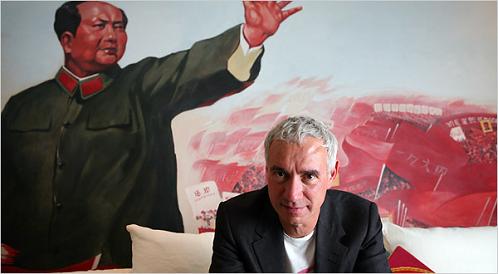
The director Roland Emmerich, best known for his high-budget, spectacle-filled films like “10,000 BC” and “Independence Day,” told his designer to make his house "as nonfrumpy as possible."
A London Home To Shock The Neighbors
Home of Roland Emmerich
Interiors designed by John Teall/Flux Interiors
Published by The New York Times, August 6, 2008
Written by Kathryn Harris
Photographed by Gavin Jackson/Arcaid
From the outside, the director Roland Emmerich’s 1830 town house looks as buttoned-up as its neighbors in the Knightsbridge district of London, near Harrods and the Victoria and Albert Museum. But once visitors step into the living room, where a taxidermy zebra is juxtaposed with a 25-foot mural of Mao, they realize they’ve left the conservative neighborhood behind.
Mr. Emmerich, who is known for big-budget, spectacle-filled films like “10,000 BC” and “Independence Day,” bought the house in late 2004 without knowing much about the area. When friends told him that it had a reputation for being somewhat staid, he instructed his designer, John Teall, of Flux Interiors, to make the house “as nonfrumpy as possible,” he said, so that “when the neighbors peek in, they might want to call the police or something.”
Mr. Emmerich had recently returned from a trip to Shanghai with a suitcase full of Chairman Mao statues, and he asked the designer to fill the house with similar objects reflecting his predilection for art with a political edge.
After making a few basic changes to the five-story house — moving the kitchen upstairs, adding skylights and creating a 16-foot-tall glass atrium — Mr. Teall, who studied interior design at the Chelsea College of Art and Design in London, set about following those instructions.
For the large murals that run throughout the house, he hired the painter James Gemmill, who duplicated works of art from the Louvre for “The Da Vinci Code.” After talking to “high-end furniture makers who gave me outrageous estimates and didn’t grasp the humor of the pieces,” he said, he commissioned film prop makers to fabricate other objects, including a life-size wax statue of Pope John Paul II and dioramas with scenes of notorious events like the actor Hugh Grant’s encounter with a Hollywood prostitute and the torture that took place at the Abu Ghraib prison in Iraq. “People can spend an entire evening discussing a film,” Mr. Teall said, explaining what some might consider obsessive attention to detail. “I liked the idea that a house might inspire the same” reaction.
For his part, Mr. Emmerich noted that “the London house has a very friendly quality.” It “started as a sort of joke,” he added, but “has become interesting — John has a wicked sense of humor.”
Slideshow: Far From Conservative
Click on each of the following images to enlarge.
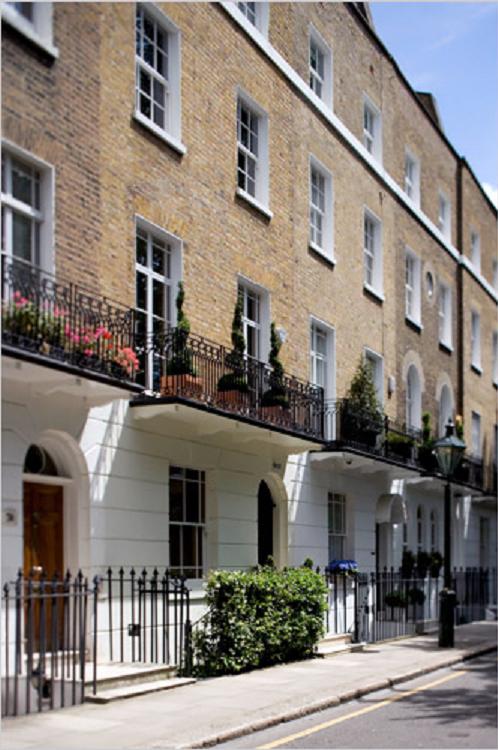
Mr. Emmerich bought the house, in the Knightsbridge district of London, in late 2004 without knowing much about the area. Friends told him that it had a reputation for being somewhat staid.
The director Roland Emmerich, best known for his high-budget, spectacle-filled films like “10,000 BC” and “Independence Day,” told his designer to make his house "as nonfrumpy as possible."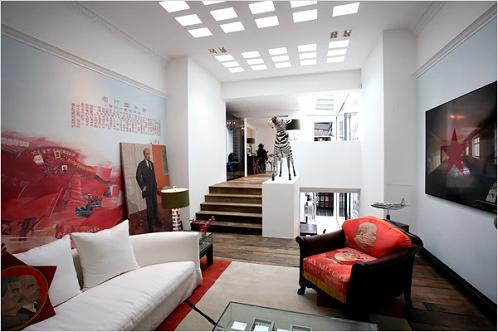
He instructed the designer, John Teall, of Flux Interiors, to make it so that "when the neighbors peek in, they might want to call the police or something." A taxidermy zebra faces the living room, which reflects his predilection for art with a political edge.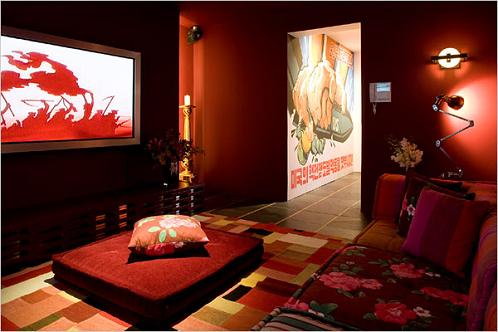
The large murals that run throughout the house were done by the painter James Gemmill.
The library coffee table is made of a missile from Iraq and holds an Arabs-and-Americans chess set commissioned by Mr. Teall. (On the Arab side, pieces include an oil rig, Saddam Hussein and a suicide bomber, and on the American side, an exploding World Trade Center, President Bush and Rambo.)
A diorama depicts John F. Kennedy's assassination.
The dining room chairs were designed by Richard Rogers and Renzo Piano. The door, a replica of one from the Ministry of Internal Affairs in Moscow, was made of wood and given a metal finish.

The walls and ceiling in an office are covered with chalkboard paint. The desk is made from a wing of a World War II plane; the chair once belonged to a military dentist.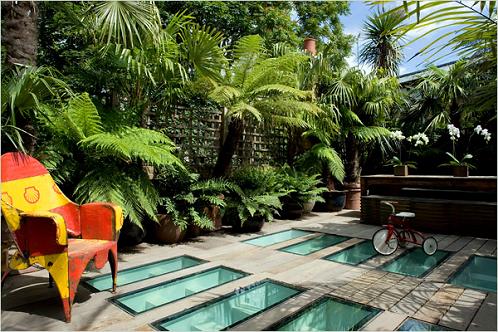
A chair on the terrace was made of Shell oil cans by children in Ghana. Benches are laser-cut with the words "insurgents" and "infidels." Skylights to the living room form the floor.

Mr. Teall had originally planned to put a life-size waxwork statue of Mr. Emmerich under the stairs. After discussing news coverage of Pope John Paul II's death with Mr. Emmerich, though, he decided it would be much funnier to depict the pope reading his own obituaries.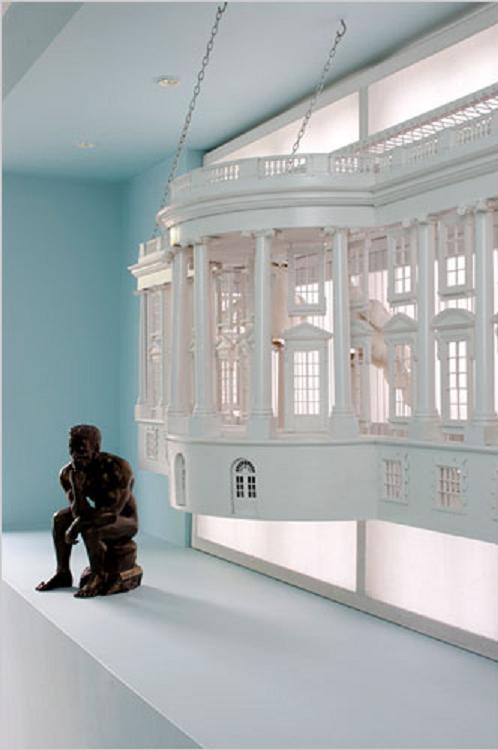
In the terrace hallway are a birdcage in the shape of the White House and a statue of Arnold Schwarzenegger inspired by Rodin's "The Thinker."
A guest bedroom features a headboard made from the wing of an airplane.
The English bedroom has Charles and Diana dolls in the fireplace.
A mural in the master bedroom was inspired by Chinese propaganda posters. The Chairman Mao sculptures, clocks and dictator nesting dolls were purchased in a Shanghai market and on eBay.
